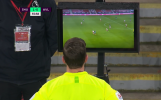RefIADad
RefChat Addict
I personally think that a DOGSO send-off is the right call, but I also think this is one of those calls where the call on the field should stand regardless of what it was. I think a caution is the incorrect call, but I also think that a caution is not a clear and obvious error. Therefore, I don't believe VAR should have stepped in to recommend an on-field review.
What this type of situation does for me is provide more evidence that VAR is re-refereeing the game more than just correcting clear and obvious errors. I'm not sure where the line is between clear & obvious error and not, but in my opinion this play is on the "keep the call on the field" side.
What this type of situation does for me is provide more evidence that VAR is re-refereeing the game more than just correcting clear and obvious errors. I'm not sure where the line is between clear & obvious error and not, but in my opinion this play is on the "keep the call on the field" side.
Last edited:



